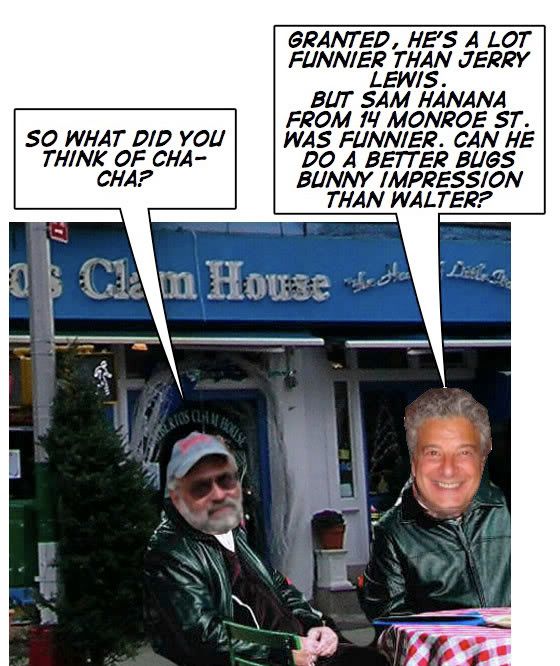
While we were near the old Majestic Hotel, it was just a short walk over to Umberto's to have lunch with and give the KV Godfather an update of recent happenings. He was asked what he thought of Cha Cha.

John Ciarcia, whom most of us know as Cha Cha began his career as a boxing promoter, one of his earliest endeavors was managing the fighting career of television celebrity, Tony Danza (this was prior to being cast in the hit sitcom “Taxi” and “Who’s the Boss”). The Madison Square Garden announcer John Condon, affectionately gave Cha Cha the nick name “The Unofficial Mayor of Little Italy” during one of the numerous boxing events held at the Garden.
John Cha Cha Ciarcia is best known in lower Manhattan as the guy you go to when you need something done! Whether it be helping young Italian immigrants learn their way through the streets of New York or casting over 400 extras for a Martin Scorcese film production, Cha Cha has always been the one to count on!
John Cha Cha Ciacia's career made the transition to acting. One of Cha Cha's earler appearances was in Martin Scorcese’s 1990 film, "Goodfellas". Cha Cha was part of the movie’s most memorable scene, as a member of Billy Batt’s (Frank Vincent) crew, he is sitting next to Billy Batts when the memorable line “Go get your shinebox” was said. This movie went on to win several prestigious awards which included an Academy Award, Directors Guild of America Award and a Los Angeles Film Critics Award. The film was also nominated for a Golden Globe, among others.
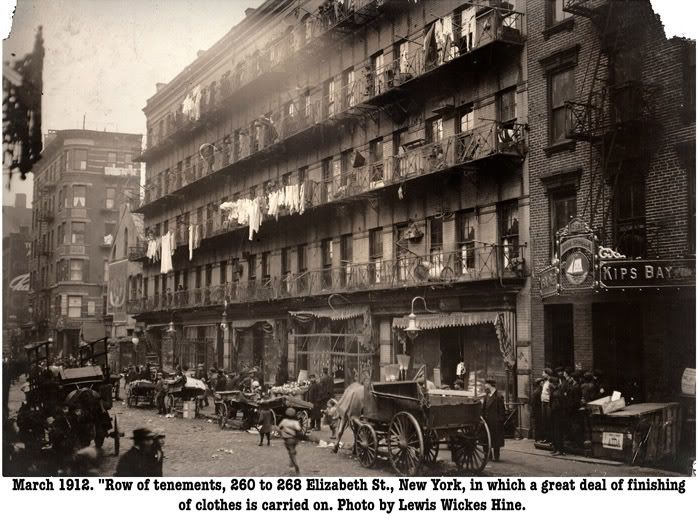
March 1912. "Row of tenements, 260 to 268 Elizabeth St., New York, in which a great deal of finishing of clothes is carried on." View full size. 268 Elizabeth Street, in Little Italy, is now a "deluxe sweater bar" called Sample; 258 (Kips Bay) is a handbag boutique called Token. Photo by Lewis Wickes Hine.
Other incidents that took place here
1883- Listed as a residence in arrest report
1900 - An alleged gambling house
1901 - Raided by police
1902 - 1908 - It was a marionette theater operated by a Senor Parisi
1910 - It was a saloon owned by Francesco La Barbera that was bombed by the "Black Hand".
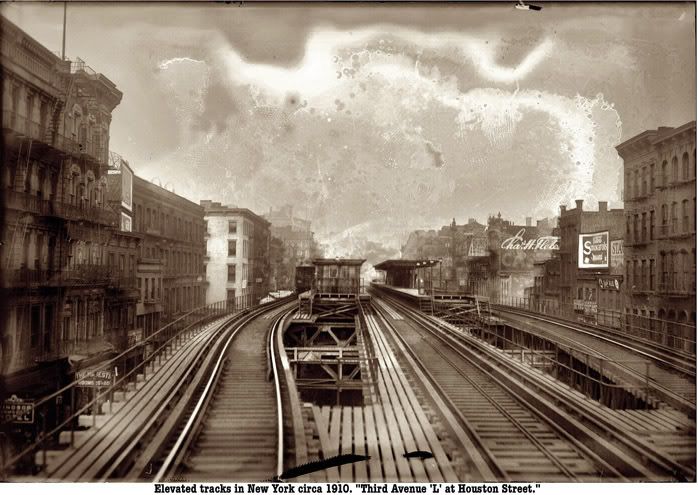
Third rail on the Els did not have coverboard like the IRT subway and most later systems. The third rail shoes were located above the rail and bore straight down on it unlike the subway type that pivots off the truck frame. Chicago transit still uses that system.
The original line here from 1878 was two single-track structures over the curb line, leaving most of the street open to the sky. Many old postcards and stereoviews show the structure in that state. This shows the rebuild as a three-track elevated over the middle of the street, which was done in 1914 or 1915.
There is most definitely a third rail there. It's easy to miss because the wooden guard rails block the view of the support chairs. I work around third rail to this day, so I literally HAVE to know how to look for it!
Perhaps you missed it. The 3rd Avenue El was electrified in 1903 when it was leased to the IRT.
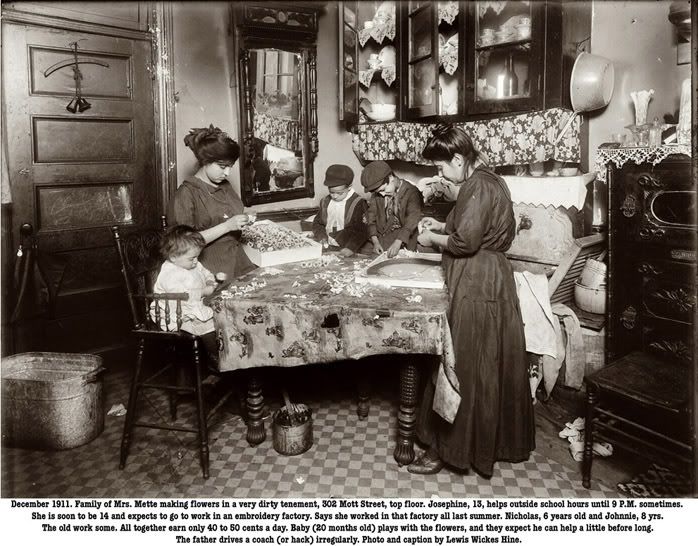
December 1911. Family of Mrs. Mette making flowers in a very dirty tenement, 302 Mott Street, top floor. Josephine, 13, helps outside school hours until 9 P.M. sometimes. She is soon to be 14 and expects to go to work in an embroidery factory. Says she worked in that factory all last summer. Nicholas, 6 years old and Johnnie, 8 yrs. The old work some. All together earn only 40 to 50 cents a day. Baby (20 months old) plays with the flowers, and they expect he can help a little before long. The father drives a coach (or hack) irregularly. Photo and caption by Lewis Wickes Hine.
This is Joe Manning, of the Lewis Hine Project. Hine had a habit of commenting about the cleanliness and neatness of his subject's houses or apartments. I suspect that it might have just been a value judgment based on his own preferences. Perhaps he was very fastidious, maybe picking that up from his mother when he was growing up in Wisconsin. We can't assume that he was just trying to exaggerate for effect. I did research on a woman who was photographed in her house in Leeds, Mass. She was putting bristles on toothbrushes. Hine's caption, in part, says, "putting bristles into tooth brushes in an untidy kitchen." I interviewed the woman's granddaughter, who had never seen the photo. When she saw the caption, she said, "Untidy kitchen? Gramma was spotless. You could eat off her floor."
Something we mention every now and then: The captions describing these tenement photos were written by photographer Lewis Hine almost 100 years ago. "Dirty" is his description. It helps to remember that he is trying to paint a bleak picture for his audience -- the U.S. Congress -- in his organization's effort to end the practice of child labor.
Poverty is not the same as being dirty. The linoleum on that floor may be a wreck from being where one enters the house. Perhaps they don't have the money to go out and replace it. The baby's high chair may also be putting black marks on the floor as it gets dragged around. They also might have to haul some coal upstairs for the stove.
These folks lived in a world of maybe 10 people in an apartment the size of the average kids bedroom these days. They are so poor that the entire family including kids is working to keep their heads above water financially. These weren't the days of handi-wipes and swiffers and vacuum cleaners and kids laying around all day playing on their computers and listening to their ipods.
BTW, the kids clothes all look very clean. Any mess on a baby is because it's a baby. There's no washer and dryer sitting nearby to pop the kid's jammies in every time they get a little mess on them
The Crusaders are an American music group popular in the early 1970s known for their amalgamated jazz, pop and soul sound. Since 1961, more than forty albums have been credited to the group (some live and compilations), 19 of which were recorded under the name "The Jazz Crusaders" (1961–1970).
In 1960, following the demise of a few short-lived Houston-based groups, pianist Joe Sample, drummer Stix Hooper, saxophonist Wilton Felder and trombonist Wayne Henderson relocated to Los Angeles, CA. After changing their name to "The Jazz Crusaders," the group signed with Pacific Jazz Records, where they would remain throughout the 1960s. Employing a two-manned front-line horn section (trombone and tenor saxophone), the group's sound was rooted in hard bop, with an emphasis on R&B and soul.
The group shortened their name to "The Crusaders" in 1971, and adopted a jazz-funk style, which really ushered in the genre which came to be known as "jazz fusion". They also incorporated the electric bass and electric guitar into their music. Bass guitarist "Pops" Popwell and guitarist Larry Carlton joined the band, and featured on the group's albums throughout most of the 1970s. With this new style came increased crossover appeal, and the group's recordings started to appear on the Billboard pop charts. The height of the group's commercial success came with 1979's Street Life, which peaked at #18 on the pop album charts and the title track from the album made the Top 10 on the R&B chart and #36 on Billboard's Hot 100 chart.
In 1975, following the release of their 28th album (their ninth as "The Crusaders"), Henderson left the group to pursue a full-time career as a producer. His departure created a void, permanently changing the character of the group. Another founding member, Hooper, left the group in 1983, thus signaling the end to the group's most popular period. Three more albums were recorded in the mid-1980s; however by the 1990s, "The Crusaders", for the most part, had disbanded, with a comprehensive discography behind them.
So far Away
Doesn't anybody stay in one place anymore?
It would be so fine to see your face at my door
Doesn't help to know that you're just time away
Long ago I reached for you, and there you stood
Holding you again could only do me good
How I wish I could, but you're so far away
One more song about moving along the highway
Can't say much of anything that's new
If I could only work this life out my way
I'd rather spend it being close to you
But you're so far away
Doesn't anybody stay in one place anymore?
It would be so fine to see your face at my door
Doesn't help to know you're so far away
Yeah, you're so far away
Traveling around sure gets me down and lonely
Nothing else to do but close my mind
I sure hope the road don't come to own me
There are so many dreams I have yet to find
But you're so far away
Doesn't anybody stay in one place anymore?
It would be so fine to see your face at my door
And it doesn't help to know you're so far away
You're so far away
Yeah, you're so far away
You're so far away
Summer journeys to niag'ra
And to other places aggra-
Vate all our cares.
We'll save our fares!
I've a cozy little flat in
What is known as old manhattan
We'll settle down
Right here in town!
We'll have manhattan
The bronx and staten
Island too.
It's lovely going through
The zoo!
It's very fancy
On old delancy
Street you know.
The subway charms us so
When balmy breezes blow
To and fro.
And tell me what street
Compares with mott street
In july?
Sweet pushcarts gently gli-ding by.
The great big city's a wonderous toy
Just made for a girl and boy.
We'll turn manhattan
Into an isle of joy!
We'll go to yonkers
Where true love conquers
In the whiles
And starve together dear, in chiles
We'll go to coney
And eat baloney on a roll
In central park we'll stroll
Where our first kiss we stole
Soul to soul
And "my fair lady" is a terrific show they say
We both may see it close, some day
The city's glamour can never spoil
The dreams of a boy and goil
We'll turn manhattan
Into an isle of joy!
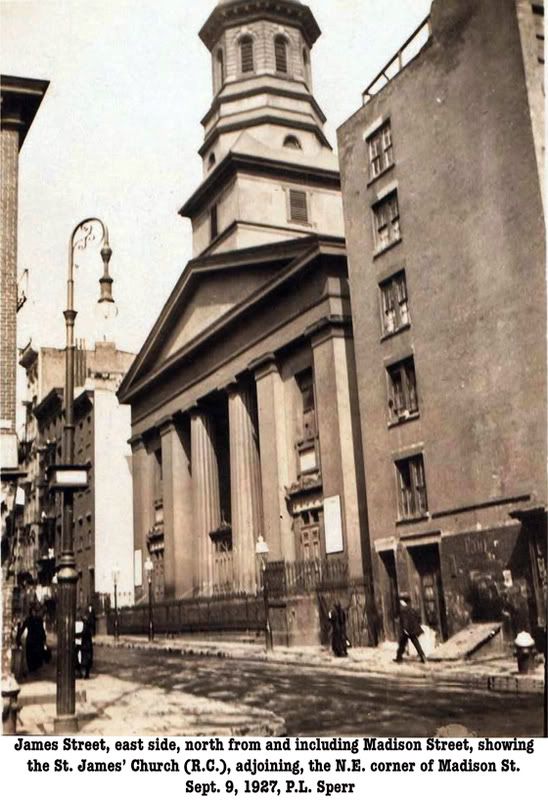
St. James' Church, New York is a Roman Catholic church located at 32 James Street in Lower Manhattan, New York City, New York. It is the second oldest Catholic building in New York, built in 1837 of fieldstone and has a pair of Doric columns flanking the entrance. Alfred E. Smith served as an altar boy at this church. This church was intended to be torn down in 1986, but was saved by the efforts of the community, especially the Ancient Order of Hibernians. The architect of the Greek Revival buliding was Minard Lafever.
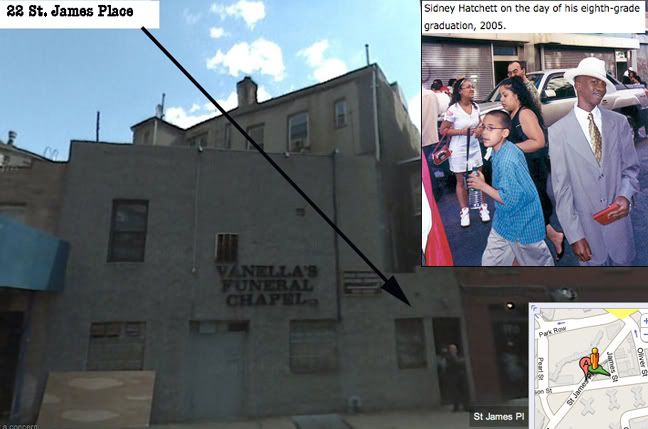
On the morning of March 10, Sidney Hatchett lay in a pale-blue coffin at the Vanella's Funeral Chapel on the Lower East Side. A slew of gifts surrounded him—a Yankees hat, three teddy bears, a white stuffed rabbit, a bundle of silk flowers. Sidney had told his mother he wanted an Akademiks denim outfit for Easter this year, so that's what she had bought for him to be buried in. There was no sign of how Sidney had died, except that his face was slightly puffy. He'd spent two days in the East River before police divers found his body. He was 14.
One week earlier, on the last day of his life, Sidney Hatchett woke up at 6:45 a.m. and started getting ready for school. Most mornings he didn't spend too much time worrying about how he looked, but on this day he pulled out his favorite sweater—the navy one with red stripes—and he ironed his cargo pants. It was 23 degrees outside, so to keep warm he put a pair of blue jeans on underneath his cargo pants. He walked his eight-year-old brother Shaquelle to his bus stop, waited with him for the bus to arrive, then headed home, stopping at a bodega to get a snack for his sister to eat later that day.
As the oldest child, Sidney regularly helped his siblings get off to school, even on those days when he didn't go himself. Sidney, who was in ninth grade, had already missed about 30 days of school this year. While he'd once been an honor roll student, he had announced recently that he didn't like school anymore. His mother didn't argue with him; instead she let him stay home. Sidney's school notified the city's Administration for Children's Services about his absences, and later today an ACS caseworker was scheduled to come to the apartment to investigate.
Now Sidney had no choice but to go back to school. He kissed two fingers and pressed them against his mother's cheek—his usual goodbye gesture—then left with his six-year-old sister Shakeema. The family lived on the Lower East Side on a short street called Rutgers Slip, just north of the Manhattan Bridge.
There was no need to walk toward the water—Shakeema's school was in the other direction—but Sidney headed that way, darting across South Street. When they reached the promenade, he took off his parka and handed it to his sister. "Bye, Keema," he said. "I'm going to jump in the water."
"No, please don't," she cried.
But Sidney had already made up his mind. He climbed over the barricade and hurled himself into the freezing river.
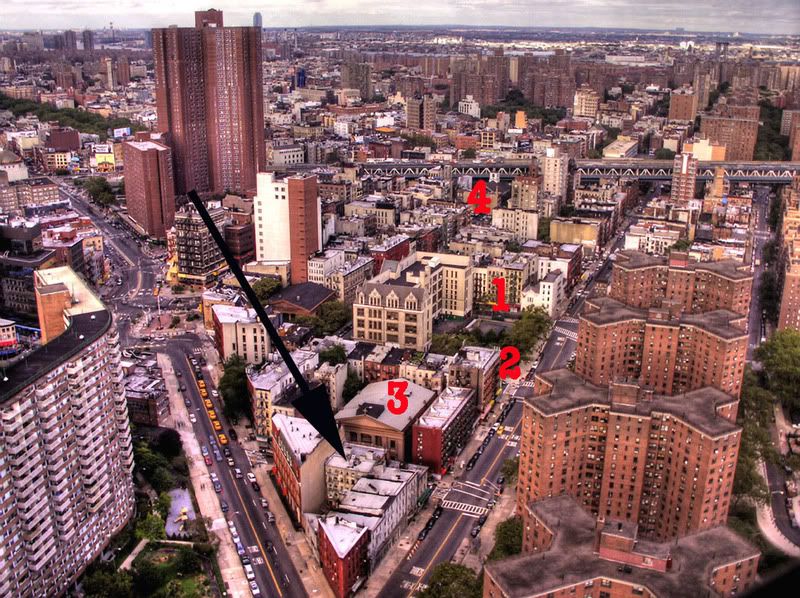

Pass rapidly under the arch of the bridge that extends from the Municipal Building to Brooklyn Bridge, near the Pulitzer Building which at the time of its erection was the tallest in the city, and is now dwarfed by buildings three times its height, pass on and you emerge to where you get a glimpse of the East River, and you are in a dark street, lined with pawn-shops and hardware shops on both sides, with dingy restaurants where saloons have been, and sulphur-smelling hotels, and drunkards decrepit and broken down, leering with shifty, watery eyes at you from every hallway, accosting you with demands for a cup of coffee and a cruller. The pullers-in of the second-hand stores cry their wares in your face, barring your way to the middle of the street. A Gipsy woman wants to tell your fortune. Half a dozen boys offer you papers. A Chinaman looks at you.
Forget that you are in New York. This is the lower part of a Levantine port. Cross one of the right-hand streets into Pearl Street. Walk up to the corner of Canal Street, after passing Fraunce's Tavern where Washington was received by his friends, and you are at the old Jewish Cemetery, which, according to the tablet on the arched door inside, beyond the huge iron fence, was inaugurated in 1656, and had been fortified during the Revolution. The cemetery is between an old wooden shanty inhabited by a Greek cobbler and an Italian grocery store on the corner. The gray and brown tombstones lean pitifully on one another as if looking for support in the last agony of their lives. Long lines of wash flutter diagonally across the burial-grounds. Colored aprons and children's dresses and underwear filled with the wind will make you think of what life is; a momentary inflation of a flexible shell and then deflation again. Thus the traveler has improved his mind by humbling himself.
Look up! Between Henry and Oliver Streets stands the massive square structure of the old Mariners Temple, which had originally been the Baptist Meeting-house in 1795. This part of Oliver Street, in rows of old red-brick houses, -is still inhabited by old Dutch families, who so much resent the foreign invasion about them that their children, if any, are seldom seen on the street. There are some wonderfully beautiful doors and copings in these old houses. The street is remarkably clean . . . but without any animation. The Greek and Italian children in the neighborhood call it Old Man's Street.
I say Greece, but I should perhaps say a Greek city; perhaps only a reproduction of the Greek quarters in Stamboul. Stamboul on the Hudson ! For though the down-town Greek section is in many respects the principal one, there are several other Greek quarters, the importance of the Madison Street district being chiefly in the fact that the Greeks living there and on the side streets leading toward the East River wharves are here with their families, while the other Greek quarters up town, between Twenty-seventh and Thirty-sixth Streets and Sixth Avenue, are only merchants' quarters. Their families are living in Greece, and their children are brought up there until they have reached the working age, when they are imported here to work, if "Patera" has not returned to Corfu or Candia a millionaire meanwhile. For whatever one may say of the Greek he is a very calculating and economical animal. It is cheaper to raise a family in Greece, where American dollars are translated into drachmas and lephtas. One can live there a month on what it would take to live here two days. The growing family is being visited every other year or so. It is absentee fatherhood with a vengeance.
One is struck on Madison Street by the innumerable coffee-houses. The windows are curtainless and the swarthy men inside play cards as furiously, as passionately, as if their lives depended on the turn of the next card. There are numerous small banking-houses, combined with barber-shop and tobacco-dealing facilities. The banker, between more important business, is keeping his fingers supple rolling cigarettes in the window of his establishment. On *the street men drag their babouches slowly.
The hurry, the noise and bustle do not affect them. They are accustomed to it from childhood. Born somewhere near other wharves, on the AEgean or the Ionian Seas, life there is at as rapid a tempo as here. Not because of individual hurry, but because of the simultaneous multitude of movements in different directions.
Madison Street, from Pearl Street to Market Street, is the main street of the principal Greek section of New York. At Market Street it ends, after thinning out at the fringe like a border town, where the Italians and the Jews are disputing for supremacy, with the Italians in the better strategic position. The boundary line at Market Street is marked by the Maternity Center. On the steps, after school hours, the older children wait for the doors to open so they can see their mothers within, and their new little brothers and sisters. It is an Italian Maternity Center. One might as well concede that, but the ground is still disputed. Close by the Maternity Center, in one building, is a Spanish barber in the basement, an Italian political association on the ground floor, and a Jewish congregation on the floor above that.
The streets branching out from Madison Street and Cherry Street, from Pearl Street on, are all occupied by Greek families. Only on the fringe toward South Street, which is the shore-line of the East River, are living Spanish families. They are mostly recent settlers, who cannot pay the high rents of the Spanish district further up town. They are wedging in in the continual displacement of group populations in the city. One can easily see the difference between the two peoples, not only in the signs on the Spanish store windows, but also in the bits of color that appear, and the red and green curtains with which the doors of the grocery stores are hung. The Spaniard loves to live behind curtains, the Greek in a show-case.
There are but few Greek stores. They are further up town. The first thing a Greek business man does when looking for a location is to ascertain there are not many Greeks living in the neighborhood. It is indeed a very difficult matter for one Greek to sell to another and make profit on the transaction.
The old houses are probably the most decrepit in the city. The rear houses especially seem unfit for human habitation, with their peeling walls and rickety stairs, and none of the modern accommodations. Even the comfort-rooms are down-stairs, as well as the water. Many of the oldest houses have no gas and are using kerosene lamps. It is only chance, and because the people living there have lived in similar conditions across the water, that fires do not occur more frequently in that district. Should anything happen, whether it begins on Cherry Street, the first house under the bridge, which is a wooden shack, or begins at the other end near Catharine Slip, the whole section might go up in flames ere the fleetest firemen could apply their hose to it. In such a holocaust I have no doubt many people would perish, for there is a great scarcity of fire-escapes or other means of saving oneself from such a catastrophe. It is interesting to note that according to official figures the density of population on the lower East Side is three times greater than the densest London quarters.
From Catharine Slip, from the corner of South Street, where the San Catharine Mission is, or from the mission-house at the corner of James Slip, standing under the sign over the barred windows, "You must be born again," one can see the spans o f three bridges, Brooklyn, Manhattan, and Williamsburg, from the same point. I know of no more magnificent sight at night when the bridges are lit; or early, on a misty morning with the gray buildings across the river rising like giant shadows into the dusky light above. It is worth while staying up late; worth while getting up early.
It took firefighters more than four hours to control a stubborn fire that ripped through a building in Chinatown early this morning – killing one person and injuries dozens more.
The fire broke out around 4 o' clock on the second floor of a building near Madison Street and Saint James Place.
The flames then spread throughout the building, causing the roof to collapse.
"We had fire on a number of floors. It's a very old building, very tight quarters inside, and we had extension very early into the fire. The fire originated on the second floor, quickly extended," said Patrick McNally of the FDNY, who said the wind and cold weather made fighting the fire all the more difficult.
A 32-year-old man who lived on the third floor of the building was found dead.
The Fire Department says 20 others were injured, four critically. Additionally, eight firefighters of the nearly 200 brought to the scene, sustained minor injuries.
Dozens of people were forced to flee. The FDNY says three people jumped from the building to escape – all are alive.
"We saw a person on the fire escape in huge clouds of smoke with fire all around her and firemen trying to get through the fence," said one witness. "They got to her. It was amazing."
Residents say the fast-moving fire trapped their neighbors and destroyed their homes.
"I have no idea what is left and what isn't," said a building resident.
"I helped one little girl get to the roof," said another. "I was huddled with everyone though. Most of our neighbors don't speak the same language, but everyone really worked together and trying to help the elderly, trying to help the kids."
"It was pitch black," said a third. "I couldn't see anything. I was in the kitchen and I lost vision, pretty much."
Red Cross and other emergency services opened a shelter at a nearby school to tend to about 60 of the building's residents. The FDNY says there are around two-dozen apartments in the building.
There is no word as to when residents of the building can return to see what's left of their belongings.
The cause of the fire is still not clear. However, Manhattan Borough President Scott Stringer says a Department of Buildings inspection last year found "defective/exposed" electrical wiring and fixtures.
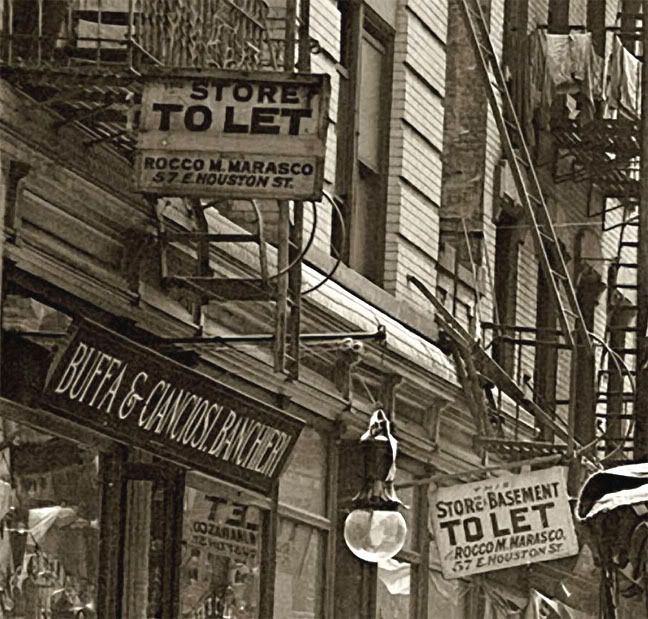


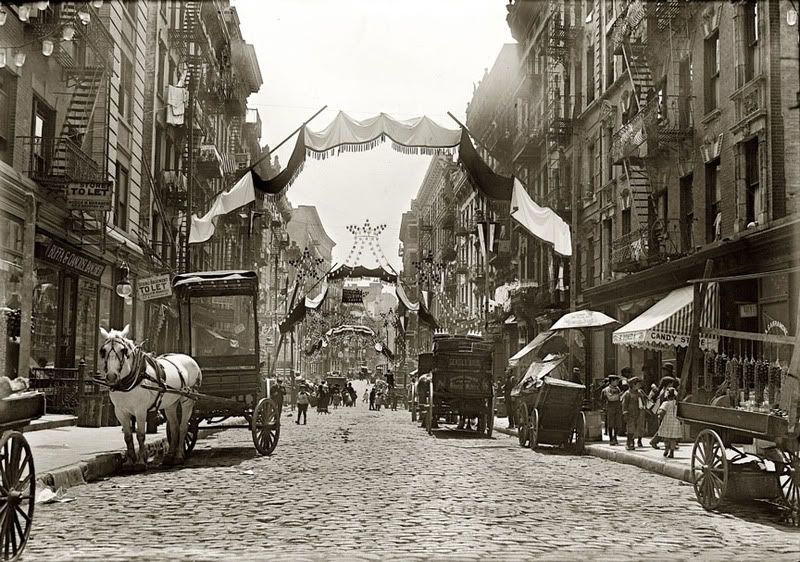

1910. Mott Street in New York's Little Italy, now Chinatown. At the left, 166 Mott (Raffaele Venezia Cafe) is now Face to Face Skin Care. Google Street View. 8x10 glass negative, George Grantham Bain Collection.Time travel, indeed
I recall a time travel novel that had as its basis the fiction that if one were to be so imbued with a time and place and strove to "live" as though you were in that period in a locale that existed now and then, one would wake up some fine day, open the shades and voila, 1910 would be there. How I wish that were true. For now I'll just sit here and revel in each detail of pictures such as this. Thanks again to Dave and all the other posters.
This is time travel in its purest sense, a view into a moment of time frozen forever. Italian cafe, shoemakers, street sweeper, horse carts, vegetable vendor, little children moving around in their home neighborhood. I love it.
The first home I remember was at 1244 15th Avenue in San Francisco. That was 1936. Went past there recently and the street looks exactly the same and it was anything but new when we lived there.
Bet you won't find today's buildings looking exactly the same 100 years from now. You're doing a wonderful job of teaching/reminding us of our history. Thank you.
Wow, I love pictures like this. Not posed at all, just a moment in time caught on film. There are kids playing with something, a guy reading a newspaper, looks like a guy jumping over a broom and every one wearing a hat. The dog, the groceries...perfect. Probably everyone in that picture has already passed on but this one moment in their lives has been captured.
Thanks for the opportunity to see this in a gorgeous and detailed vintage view and in an interesting modern view. I am a big fan of the "Then and Now" type books on different cities, and love to compare shots such as these. While I prefer the 1910 photo (if only filmmakers would get this kind of detail in their period-piece movies!), the Google shot has an interest all its own by virtue of one's being able to manipulate the view! Quite amazing, actually.
Mott Street, 1925 and today
This is a fine neighborhood for Dim Sum, and another site immortalized in popular song lyrics, this time in the 1925 Lorenz Hart song "Manhattan":
And tell me what street
Compares with Mott Street
In July?
Sweet pushcarts gently gliding by.
The great big city's a wondrous toy
Just made for a girl and boy.
We'll turn Manhattan
Into an isle of joy.
Wow! I walked down that street in December when I was visiting NYC (I'm from Brisbane, Australia). I love the black dog on the right. Somehow, I always spot the dogs.
I love that the buildings have changed barely at all. Really interesting to think of the history in those buildings that the people living there now have probably never considered.

Another view of Mott Street in New York's Little Italy (now Chinatown) circa 1910. The building in the middle, 156 Mott, with the Italian pharmacy, is now the Foot Reflexology Center in this Google Street View. The address on the right, 156 Mott, is now just two stories. Most of the basement entrances have been covered.
Looks like the Bert Pilsner Beer hall isn't there anymore. What a shame. It looked like a neat building. Also, can you believe some of the original fire escapes are still being used. I wonder if they are still up to code.
Submitted by J Gioia on Wed, 05/21/2008 - 6:04am.
My great-great grandfather ran an Italian pharmacy a few blocks away, on Mulberry Street below Canal. Wong's Noodle Shop is now in its place.
Aliquippa is a city in Beaver County, Pennsylvania, and is part of the Pittsburgh metropolitan area. Formerly a borough, it was formally named a city in 1987 by the Aliquippa Council.
Aliquippa was founded by the merger of three towns: Aliquippa (now called West Aliquippa), Woodlawn, and New Sheffield. There is no evidence connecting the Seneca Queen Alliquippa with the location of the borough. This was one of several Indian names selected arbitrarily by the Pittsburgh and Lake Erie Railroad in 1878 for stations along the route. Aliquippa is best known as the location of a productive steel mill that the Jones and Laughlin Steel Company constructed there along the Ohio River beginning in 1905. Employment at the facility sustained a population of 27,023 in 1940. The mill closed during the collapse of the steel industry during the 1980s. This major economic loss alongside suburbanization caused a major population loss through the end of the 20th century. The oldest church without the current boundaries of Aliquippa is Mt. Carmel Presbyterian Church (formerly White Oak Flats Presbyterian Church), established about 1793 in the New Sheffield region on Brodhead Road. Much of the city's businesses have left since the closing of the mill, which has left the area economically depressed. Recently, there have been small initiatives undertaken to help rejuvenate Aliquippa. In early 2008, Geneva College students were sent on a mission trip to help restore old buildings in the community. One structure that was successfully repaired now houses the Uncommon Grounds Coffee Shop.
 Image source
Image sourceMY MOTHER WAS NANCY MUCERINO, THE YOUNGEST OF 13 CHILDREN. BORN AND RAISED AT 104 BAYARD STREET. WHEN I WAS A KID, ALL FOUR FLOORS FACING BAYARD WERE MY AUNT'S AND UNCLE'S APARTMENTS. MUCERINO'S ON THE FIRST (MY UNCLE PAT) AND SECOND FLOORS (MY AUNT MOLLY). GERAGE (MY AUNT NEDDY) ON THE THIRD FLOOR AND PALATTO (MY AUNT ANNIE) ON THE 4TH FLOOR. AT 94 BAYARD, NOW A PARKING LOT WHERE DENNIS M. WORKS, MY UNCLE JOHN MUCERINO LIVED IN A PENTHOUSE APARTMENT HE BUILT ON THE ROOF ABOVE THE LAST FLOOR. THERE WAS A BACK BUILDING WHERE MY UNCLE BILL MUCERINO LIVED AT 104 BAYARD STREET. 102 BAYARD STREET ALSO HAD A BACK BUILDING. A BACK BUILDING'S FRONT FACES THE BACK OF THE FRONT BUILDING'S BACKYARD, WITH A SMALL COURTYARD IN BETWEEN. THAT'S WHERE THE OUTHOUSES FOR BOTH BUILDINGS WERE BEFORE BATHROOM PLUMBING WAS INSTALLED IN THE 1930'S. ON THE GROUND FLOOR WAS HAPPY'S BAR (FORMER THE RED HORSE BAR).
The Scene
The waiters and the owner at this seedy little bar are unconscionably rude, and the female hostesses can't make a drink to save their lives--something about their foxy attire makes you think they weren't hired for their skills behind the bar--but everyone, from police officers to white-collar Wall Street boys, flocks to Winnie's.
The Draw
OK, so you have to pay. But from "Hotel California" to "Love Me Tender," they've got all your favorites on the machine, and the hostesses love to sing duets with the occasional "special" customer--who could be anyone from a little person to an eye patch-sporting six-footer.
No other karaoke bar exerts the magnetic pull on both hardcore Asian mic fiends and downtown hip kids that Winnie's does. Here you'll witness not just mangled "Endless Love"s but a bracing dose of Mandarin pop songs favored by the local clientele, as well as by Winnie herself, who often shows up to survey the booze-drenched scene. The staff quickly makes you feel like family too, offering shots of "Hawaiian Punch"—a lethal concoction that will have you passed out in one of the oversized red booths in no time. You won't even notice the convicts being led in shackles into the Manhattan Criminal Courthouse next door. — Matt Dobkin
Karaoke $1 per song
great pace - easy going - no hold barred [ except when i tried to sing accapella ] if you're lucky, winnie and her brother walter will treat you to a cantonese classic on a late saturday night
This is a dive bar, that is part of the attraction. Drinks are decent priced, people are very friendly... it is always a fun time. Many places charge for the songs.... so what.... I would rather hang here than any of...
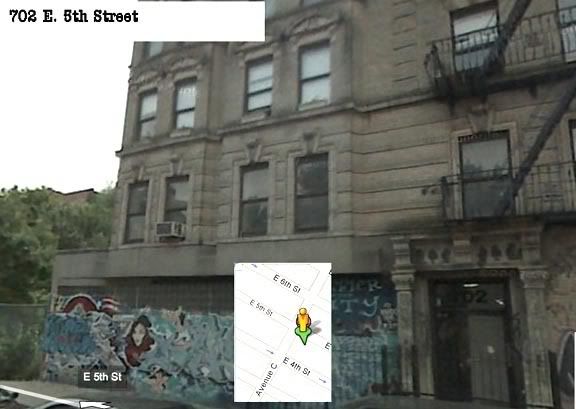
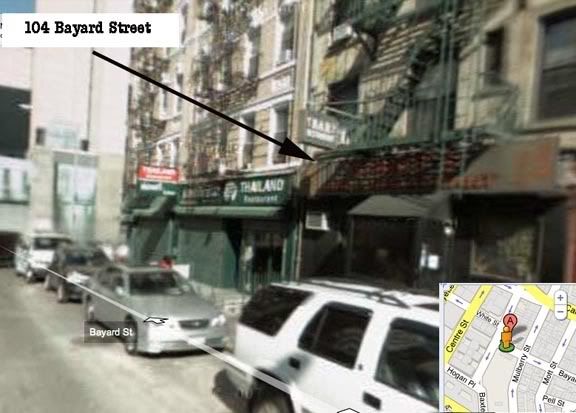
SAL LIVED AT 104 BAYARD STREET, AS DID HIS MOTHER, MY MOTHER AND 11 OTHER BROTHERS AND SISTERS. IN FACT, THEY WERE ALL BORN AT 104 BAYARD STREET. RIGHT ACROSS FROM THE PARK HOUSE, WHICH WAS AN OUTDOOR DANCE HALL IN THE EARLY 1900'S. THE BAR BELOW THE BUILDING USED TO BE HAPPY'S BAR. NOW IT IS NOW WINNIE'S, A KARAOKE BAR AS WELL AS A HANGOUT FOR SOME OF QUESTIONABLE CHARACTER.
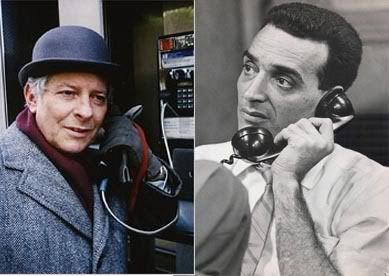
TWO Fridays ago, I reached out to Joe Goldstein. The notable publicist and unofficial NBA encyclopedia had sent me a note a while back on Ossie Schectman, his Boca Raton buddy and earliest (1946-47) Knick. I promised his request would make the column the Sunday after the All-Star Game.
Then I asked Joe for a favor. That's how we do. Sal Gerage's health was plainly failing. I knew he and Joe went way back. Blanks needed to be filled regarding the virtuoso newspaper career of the first editor who took the time to critique my undisciplined copy, didn't mutilate my already-flimsy confidence and pushed me hard to cultivate what he felt was an original style.
It took all of one weekend for Joe to provide the answers. They had graduated from Seward Park High School just after D-Day in June of 1944. Senior year, both had worked as copy boys for afternoon dailies.
Dissuaded by his father from following in his frozen footsteps at the Fulton Fish Market, Sal took a job at the World Telegram in the sports department. Joe was hired by the New York Sun. Six years later, the two papers merged and became the World-Telegram and Sun.
"Sal became known as a wonder boy," e-mailed Joe, who decided around that time to become a press agent, learning the nuances by hanging around Haskell Cohen, the NBA's first PR man.
Meanwhile, Sal became a valued sports desk person, working the midnight-to-eight lobster shift and putting out the first edition.
"When the Journal American ceased publication, Sal became the sports editor of the mixed operation," Joe reported. "This means he was the sports editor of the new, but not-destined-to-survive paper. He was selected over Harold Claussen and Max Kase.
"The World Journal Tribune represented a fusion of seven newspapers - the Journal, the American, the Evening and Morning World, the Sun, Herald and Tribune. With the demise of the World Journal Tribune, Sal went to the Daily News, then owning a daily circulation of two million plus, as Brooklyn editor, which included Queens and Nassau/Suffolk. For a time, he was sports editor."
Last Wednesday, on my way to Phoenix for the All-Star Game, I called Joe in Florida to thank him for the newspaper history lesson and for setting Sal's career straight sequentially.
Two days later, Joe died at age 81 after suffering a stroke and a heart attack. At last count, 44 articles celebrated his flamboyant life and chronicled his colorful client list that featured Smokin' Joe Frazier, who attended Tuesday's standing-room-only service with his son, Marvis.
 So Al starts the ball rolling on Jerry
So Al starts the ball rolling on JerryFor those cinemaphiles out there. Tonight's Academy Award ceremony will be honoring Jerry Lewis with a lifetime achievement award. Presentation of the award is usually one of the highlights of the show. Jerry Lewis, along with Dean Martin was an integral part of my television viewing experience, growing up. Jerry is 83 now, it should be an interesting moment considering the bizarre relationship that he's had with Hollywood. Enjoy it
I heard that Jerry was connected to the mob and Dean wasn't. I didn't think he was that funny
No, Dean was connected too
I KNOW A FEW GUYS IN THE BUSINESS WHO KNEW JERRY LEWIS. THEY SAID HE'S A TALENTED GUY BUT A REAL SC..BAG. NOT A NICE PERSON AT ALL. HIS NOT-SO-NICE PERSONALITY HELD HIM BACK IMMENSELY IN SHOW BUSINESS. DEAN MARTIN, ON THE OTHER HAND, I HEARD WAS A REAL NICE GUY. THE ONLY RAT PACKER WHO DIDN'T RUN AROUND WITH GIRLS AND HE DRANK, BUT NOT AS MUCH AS PEOPLE THOUGHT. AND HE WAS A SWEETHEART TO WORK WITH, WHILE LEWIS WAS DECIDEDLY NOT. WHEN MARTIN AND LEWIS SPLIT, THE PREVAILING NOTION WAS THAT LEWIS WOULD BE A HUGE SUCCESS AND MARTIN A NO-TALENT FLOP. IN FACT, LEWIS WAS A MODERATE SUCCESS HERE IN AMERICA, BUT REAL BIG IN FRANCE, WHICH TELL US MORE ABOUT FRANCE THAN IT DOES ABOUT JERRY LEWIS. THE TELETHON GAVE LEWIS THE MOST VISIBILITY HERE IN THE USA. STORIES LATER SURFACED THAT LEWIS MADE A TON OF MONEY DOING THE TELETHONS, WHICH HE DENIED. BUT WHO KNOWS? THAT DID NOT HELP HIS IMAGE EITHER. MARTIN, ON THE OTHER HAND, BECAME A HUGE SUCCESS AFTER THE BREAKUP. SURE SINATRA HELPED HIS PAL, BUT DINO COULD SING WITH THE BEST OF THEM AND WAS A DAMN GOOD ACTOR TOO. AND HIS WEEKLY TV VARIETY SHOW WAS A HUGE SUCCESS. NO ONE SUSPECTED IT WAS LEWIS HOLDING DINO BACK IN THE PARTNERSHIP, RATHER THAN THE OTHER WAY AROUND. FUNNY HOW THINGS SOMETIMES WORK OUT.I LIKE JACKIE MASON BETTER. MORE CONTROVERSIAL. TELLS JOKES. HAS HUGE GULLIONES. JERRY LEWIS WAS TOO LOONEY FOR ME. JIM CARREY IS THE SAME AND I'M NOT CRAZY ABOUT HIM EITHER. AND WHAT ABOUT MYRON COHEN?? HE MADE ME FALL DOWN LAUGHING.
Personally, I never more cared for Jerry (Lewis, that is).I heard the Dean was a real mensch. He refused to work any more on Marilyn Monroe's last picture after the studio fired her and I don't think he was even schtupping her.
Interestingly, although for years Jerry has raised millions of dollars for the Muscular Dystrophy Assn, many with MD and other severe physical disabilities protest the telethon each year and can't stand him. They're not "Jerry's Kids," never wanted to be, and feel that over the years in raising $ he has created a terribly negative stereotype of those with physical disabilities, while feeding his ego. They have a point.
Whenever he was on tv my grandmother would say, "There's the meshuggana."
Hope he doesn't try to sneak a gun in. He's made some technological advances in film, but he's an a.... and he screwed over his first wife. The Jean Hersholt Humanitarian Award is meaningless anyway since they gave it to Elia Kazan.
looking forward to the awards even though didn't see any of the movies ... the lifetime achievement award is always an emotional moment and tonight should be no different especially having grown up with Jerry Lewis. In 1961 I went with Barry Dolinko to the Loews 2nd Avenue ... the movie theater that would become The Fillmore East ... the big attraction was that Jerry Lewis was going to be appearing live onstage before one of his movies ..I still remember, he showed up in a black suit .. looked very tall on stage ... since it was '61, the movie was either The Errand Boy or The Ladies Man ... think it was Errand Boy .. anyway ...in our generation if you had to choose a King of Comedy its a no-brainer - Jerry Lewis ..amazing he's going to be 83 next month (March 16) ... should be something special .
Perhaps no other performer in the 20th century made more awkward statements than Jerry Lewis. His list of hits and misses is unequaled, and I mean both professionaly and off the stage. Often when Jerry was out of his bombastic character, appearing as himself, he seemed somewhat incapable of ... well I don't know of what ... but it was always awkward. Take for instance this 1967 appearance on the game show Password hosted by Allen Ludden. On the show a celebrity was teamed up with a non-famous contestant. Oh, that poor, poor contestant playing with Jerry Lewis. Lewis looks like he'd like to murder the guy.
Long ago and far away, I dreamed a dream one day
And now that dream is here beside me
Long the skies were overcast but now the clouds have passed
You're here at last
Chills run up and down my spine, Aladdin's lamp is mine
The dream I dreamed was not denied me
Just one look and then I knew
That all I longed for long ago was you
Chills run up and down my spine, Aladdin's lamp is mine
The dream I dreamed was not denied me
Just one look and then I knew
That all I longed for long ago was you
Long ago a young man sits and plays his waiting game
But things are not the same it seems as in such tender dreams
Slowly passing sailing ships and Sunday afternoon
Like people on the moon I see are things not meant to be
Where do those golden rainbows end?
Why is this song so sad?
Dreaming the dreams Ive dreamed my friend
Loving the love I love
To love is just a word Ive heard when things are being said
Stories my poor head has told me cannot stand the cold
And in between what might have been and what has come to pass
A misbegotten guess alas and bits of broken glass
Where do your golden rainbows end?
Why is this song so sad?
Dreaming the dreams I dream my friend
Loving the love I love to love to love to love
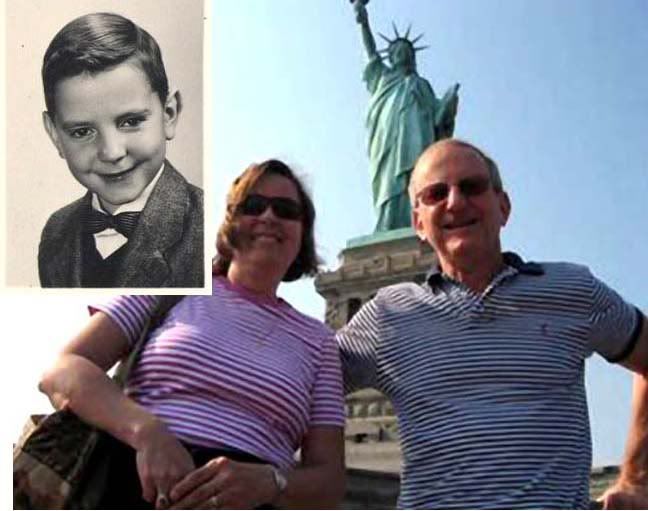
Walter's Bugs Bunny imitation has remained vivid to me through almost six decades.
From: Walt Charen, Subject: Very long ago and far away, To: David
The mind works in strange and wondrous ways. Hadn’t thought about the ‘number’ of our elementary school in decades. Then, all of a sudden, it popped into my consciousness – PS 177. I GOOGLED it, and what do you know, your name popped up! I moved away to Colorado after 5th grade. My dad had been accepted for a doctoral program after working as a high school teacher for many years. Anyway, I never returned to NYC. After two years in Boulder, we moved back to NJ, where I attended HS. Then, went to Rutgers, New Brunswick. Didn’t study pre-med, but went to St. Louis University School of Medicine despite that. Graduated with a MD in 1970. Did residency in psychiatry at the University of Connecticut. Practiced 14 years in Hartford, then heeded the siren song of arecruiter for Charter Medical, and took position as Director of a hospital on St. Simons Island, GA. Am still here. I retired from practice in 1996, and went to work full time for the advertising agency I started in 1993 on a part time basis. Medicine had become a struggle involving mountains of paper work, and little time for actually seeing patients. So, I quit. Got married in 1973, and remain happily so. I have two children. My son is 29. My daughter is 23. If you are interested in seeing how my creative impulses are being expressed in my current profession, you can visit our web site. I write all the scripts. I’ll attach a recent picture. Karen and I on business/vacation trip in the old home town last year. Probably won’t mean much, as lots of water has gone under the bridge, but maybe you’ll see some resemblance to an old memory. Hope you and yours are well, and would like to hear about how life has treated/is treating you.
Walt Charen

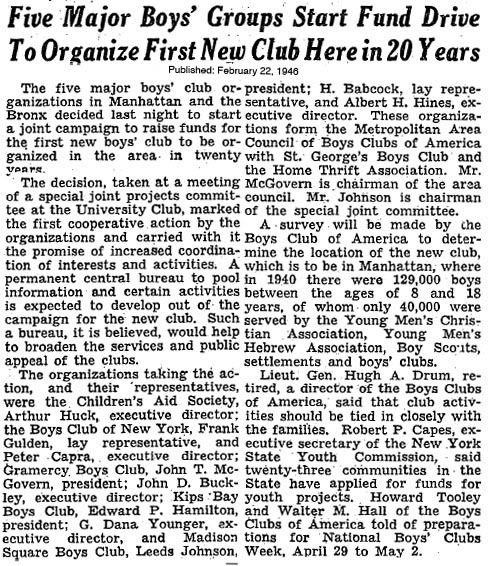
The Rev. Dr. George D. Younger, noted American Baptist executive, pastor, historian, educator and community leader, died Nov. 21 after a long illness. He was 75. Younger served as executive minister of the American Baptist Churches of New Jersey, one of 34 regions within American Baptist Churches USA, from 1976-1992. Under his leadership the region established new churches and missions, focusing in part on churches to serve recent immigrants from Haiti and Central America. As executive minister he was active in leadership roles within the American Baptist Churches USA. Younger long was active in urban ministries work, notably in leadership at the Metropolitan Urban Service Training Center in New York City (1968-1972), as executive director of the Urban Training Center for Christian Mission in Chicago (1972-1976) and as pastor of Mariners' Temple in New York City (1955-1966). While at Mariners' Temple he helped found Mobilization for Youth, a pioneering anti-poverty agency. He was the editor of Foundations: A Baptist Journal of History and Theology from 1957-1968 and was on the Management Council of The American Baptist Quarterly, the Society's current journal. Younger has been named Honorary Life Member of the American Baptist Historical Society last month.
Younger was program associate in the American Baptist Home Mission Society's Division of Evangelism from 1966-1968, where he focused on issues of housing and urban planning.
He served as adjunct professor and taught Baptist history, theology, polity and ecumenism at Union Theological Seminary (1986-1999), New Brunswick Theological Seminary (1987-2001), Drew Theological School (1991-2001) and Princeton Theological Seminary (2001).
He recently served as the representative to the United Nations for the Baptist World Alliance.
His wife, Dodie Younger, has served leadership roles with American Baptist Women and Church Women United, among other organizations. Condolences may be sent to the Younger family at 333 Elmwood Ave., Apt. J321, Maplewood, NJ 07040-2429.

When the Manhattan and Williamsburg Bridges were built at the turn of the century, their long access ramps cut huge swaths through the tenement neighborhoods lining the East River. These grand entries were meant to inspire further initiatives in urban beautification but instead they still rise incongruously from rundown surrounding streets. The disparity is particularly acute at the Manhattan Bridge, which empties into Chinatown at the congested intersection of Canal Street and the Bowery.
Abbott used the walkway on the entry ramp of the Manhattan Bridge as an ideal vantage point for photographing some of the Lower East Side. In a discarded image, she reworked a composition attempted earlier, looking south toward the Brooklyn Bridge and the Wall Street skyline (Manhattan Bridge, variant image 3). The strong sunlight falling along Cherry Street leads the eye deep into the picture space. On the right rises the broad facade of the innovative low-income housing project Knickerbocker Village (1934), and on the left is the Hearst newspaper plant, currently used by the New York Post.
Moving west along the bridge and turning the camera southwest, Abbott photographed the intersection of Market and Henry Streets. The foreground is dominated by the Church of Sea and Land, originally a Dutch Reform Church which dates to 1817. This view nearly duplicates that of Henry Street, taken from ground level and partway down the block. The church is now the First Chinese Presbyterian Church, and on the site of the parking lot (in the lower left of the photograph) is a 14-story apartment building.
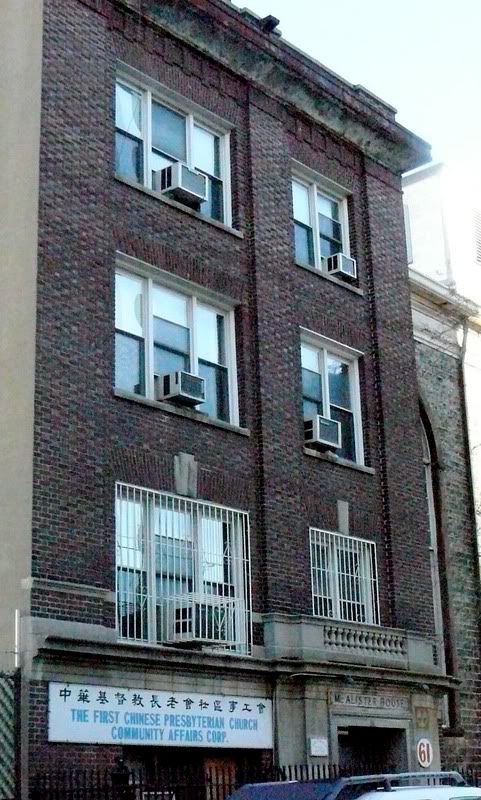
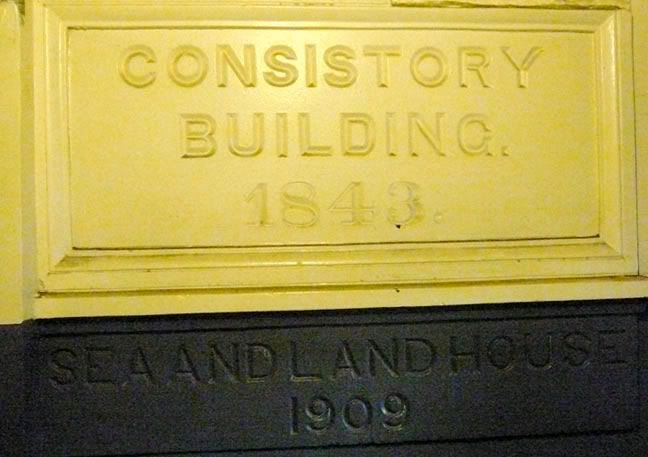

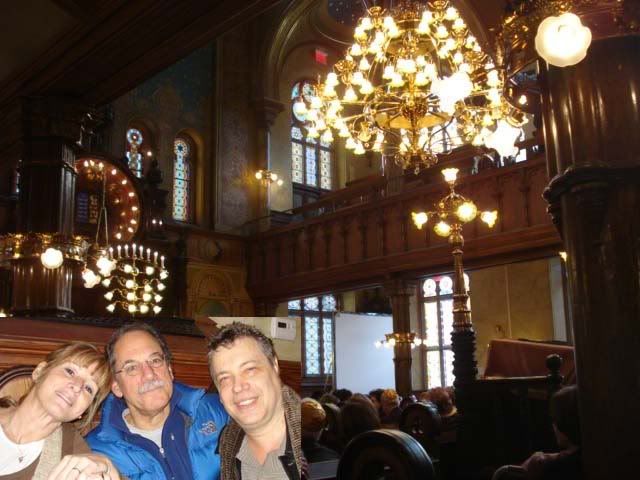
Came here in the early 1950's, living in Knickerbocker Village, right next door to by good buddy, Marty (sitting here). My grandfather Joseph and my father Moe davened here usually just for the High Holy Days, although my grandfather was more observant and lived for a time on the LES. He would come during the week. Visiting today, I had a chance to sit in the pew where I sat for several years with my father and grandfather. I had a wonderful recollection of my father tickling me with fringes of his Tallis. I also must say that I couldn't stand sitting in the sanctuary all day and my friends and I would cut out with all kinds of excuses and run around the basement and the streets outside the synagogue playing Hide and Seek and Ring-a-leevio. Problem was we got all sweaty and dirty and our fathers knew just what we were doing. We heard about it on the way home.
Friend of Bob Nathanson, who taught me everything I know...
When I was a kid I went to the Pike Street Synagogue. I remember going there with my grandmother on a night when they were blowing the Shofar and like Bob, whenever I would go to a synagogue, I would spend most of my time outside. I remember when my grandmother came out, she said to me "Did you hear the Shofar?" I subsequently learned that all Jews are supposed to hear the Shofar when it is blown on the High Holidays. She got very upset and started to cry. I said, "Grandma, did you mean that horn thing?" and she would stop crying. I remember walking back to the house with her. It was a defining memory of my grandmother, Goldie.








